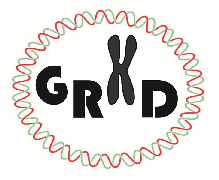Center for Gene Regulation in Health and Disease (GRHD)
Mailing Address
Center for Gene Regulation in Health and Disease (GRHD)
2121 Euclid Avenue, SR 259
Cleveland, OH 44115
Campus Location
2351 Euclid Avenue
Science and Research Building, Room 259
Phone: (216) 687-2516
Fax: (216) 687-5549

Dr. Girish Shukla

Professor
Location: SR 262
Phone: (216) 687-2395
Fax: (216) 687-6972
My research goal is to understand better molecular mechanisms that control eukaryotic gene expression at the RNA level. Within this framework, I am exploring three issues: (1) noncoding RNAs and their roles in gene expression, (2) nuclear pre-mRNA splicing, (3) specific RNA: RNA and RNA: Protein interactions, and finally (3) post-transcriptional control and cancer therapeutics. The current emphasis of the lab is on miRNA-mediated regulation of human androgen receptor expression and post-transcriptional control of steroid biosynthesis. Androgen receptor is a critical modulator that has been implicated in hormonal dependent and independent stages of prostate cancer. Based on computational predictions and phylogenetic analysis, I have proposed a miRNA-mediated model of Androgen Receptor regulation. One fascinating idea that I would like to investigate further is the critical level of the Androgen receptor that influences the transition from the hormone-dependent to the hormone-refractory stage of prostate cancer. Using computational biology tools, we have identified many miRNAs that can potentially interact with the 3' untranslated region of the receptor mRNA. This observation gives rise to the hypothesis that androgen receptor expression is tightly regulated by combinatorial control of miRNAs, and deregulation of these miRNAs may contribute to prostate cancer progression. We have identified several rate-limiting critical enzymes in the steroid biosynthesis pathways that have the potential for targeted cancer therapy. We are focusing on the molecular mechanisms of these enzymes using a variety of cutting-edge molecular tools.
The research in my laboratory also aims to understand nuclear pre-mRNA splicing by using in vitro and in vivo methods. We are currently studying the structure-function of several snRNAs of the minor spliceosome, including U11, U12, U4atac, and U6atac. Recently we have identified a small RNA element in the U6atac snRNA that functions in the 'guiding' of the specific spliceosomal complexes to the minor class splice sites. We are now pursuing the identification of proteins that may interact with these U6atac snRNA sub-structures to define their role in the minor spliceosome further. We are also studying specific RNA-RNA base-pairing interactions involved in splicing the minor class intron using biochemical and in vivo genetic approaches. These studies will help us understand how multiple sequentially interacting snRNAs facilitate the removal of introns from the precursor mRNA of genes.
Asmita Bhattarai
PhD Student
Location: SR264
(216) 523-7422
asmitabhattarai1@gmail.com
- Kumar, A., Kumar, V., Shukla, G.C., and Rao, K.V., Immunological characteristics of a recombinant Hepatitis B virus derived multiple-epitope polypeptide: a study in polyvalent vaccine design. Vaccine; 1994, 12(3): 259-66.
- Shukla, G.C. and Nene, V., Telomeric features of Theileria parva mitochondrial DNA derived from cycle sequence data of total genomic DNA. Mol. Biochem. Parasitol. 1998, 95, 159-163.
- Shukla, G.C. and Padgett, R.A. Features of U6atac and U12 snRNA are conserved in plants and higher organisms RNA, 1999, 5:525-538.
- Shukla, G.C. and Padgett, R.A. The intramolecular stem-loop of U6 snRNA can functionally replace the U6atac snRNA stem-loop. RNA, 2001, 7:94-105.
- Dietrich, R.C., Shukla, G.C., Fuller, J. D., and Padgett, R.A. Alternative splicing of U12-dependent introns in vivo responds to purine-rich enhancers RNA, 2001, 7:1378-1388.
- Padgett, R.A. and Shukla, G.C. A revised model for U4atac/U6atac snRNA base pairing. RNA, 2002, 8:1-4.
- Shukla, G.C., and Padgett R.A. A catalytically competent group II intron domain 5 can functionally replace the spliceosomal U6atac snRNA stem-loop Mol. Cell 2002, 9:1145-1150.
- Shukla, G.C., and Padgett, R.A. U4 small nuclear RNA can function in both the major and minor spliceosomes Proc. Natl. Acad. Sci., 2004, 6, 101 (1): 93-98.
- Shukla, G.C., Cole, A. Dietrich, R.A. and Padgett, R.A. Domains of human U4atac snRNA required for U12-dependent splicing in vivo Nucl. Acid Res., 2002, 30, 21: 4650-4657.
- Dietrich RC, Padgett RA, Shukla GC*. The conserved 3' end domain of U6atac snRNA can direct U6 snRNA to the minor spliceosome. RNA. 2009 Jun;15(6):1198-207.
- Sikand K, Slane SD, Shukla GC*. Intrinsic expression of host genes and intronic miRNAs in prostate carcinoma cells. Cancer Cell Int. 2009 Aug 12;9(1):21.
- Sikand K, Shukla GC. Functionally important structural elements of U12 snRNA. Nucleic Acids Res. 2011 Oct;39(19):8531-43. Epub 2011 Jul 6. PubMed PMID: 21737423; PubMed Central PMCID: PMC3201867.
- Sikand K, Slaibi JE, Singh R, Slane SD, Shukla GC. miR 488* inhibits androgen receptor expression in prostate carcinoma cells. Int J Cancer. 2011 Aug 5;129(4):810-9. doi: 10.1002/ijc.25753. PubMed PMID: 21710544.
- Shukla GC, Haque F, Tor Y, Wilhelmsson LM, Toulmé JJ, Isambert H, Guo P, Rossi JJ, Tenenbaum SA, Shapiro BA. A boost for the emerging field of RNA nanotechnology. ACS Nano. 2011 May 24;5(5):3405-18. PubMed PMID: 21604810; PubMed Central PMCID: PMC3102291.
- Sikand K, Barik S, Shukla GC. MicroRNAs and Androgen Receptor 3' Untranslated Region: A Missing Link in Castration-resistant Prostate Cancer? Mol Cell Pharmacol. 2011;3(3):107-113. PubMed PMID: 22468168; PubMed Central PMCID: PMC3315684.
- Shukla GC, Singh J, Barik S. MicroRNAs: Processing, Maturation, Target Recognition and Regulatory Functions. Mol Cell Pharmacol. 2011;3(3):83-92. PubMed PMID: 22468167; PubMed Central PMCID: PMC3315687.
- Sikand K, Singh J, Ebron JS, Shukla GC. Housekeeping Gene Selection Advisory: Glyceraldehyde-3-Phosphate Dehydrogenase (GAPDH) and β-Actin Are Targets of miR-644a. PLoS One. 2012;7(10):e47510. doi: 10.1371/journal.pone.0047510. Epub 2012 Oct 16. PubMed PMID: 23091630; PubMed Central PMCID: PMC3472982.
- Ebron JS, Weyman C, Shukla GC. Targeting of Androgen Receptor expression by andro-miRs as novel adjunctive therapeutics in Prostate Cancer, Journal of Cancer Therapy, 2013.
- Singh G, Shukla GC, Gupta S. MicroRNA regulating Glutathione S-transferase P1 in Prostate Cancer, Curr Pharmacol Rep, 2015.
- Al-Harbi S, Choudhary GS, Ebron JS, Hill BT, Vivekanathan N, Ting AH, Radivoyevitch T, Smith MR, Shukla GC, Almasan A. miR-377-dependent BCL-xL regulation drives chemotherapeutic resistance in B-cell lymphoid malignancies. Mol Cancer. 2015 Nov 4;14(1):185. doi: 10.1186/s12943-015-0460-8. PubMed PMID: 26537004; PubMed Central PMCID: PMC4632834.
- Singh S, Zheng Y, Jagadeeswaran G, Ebron JS, Sikand K, Gupta S, Sunker R, Shukla GC. Deep sequencing of small RNA libraries from human prostate epithelial and stromal cells reveal distinct pattern of microRNAs primarily predicted to target growth factors. Cancer Lett. 2016 Feb 28;371(2):262-73. doi: 0.1016/j.canlet.2015.10.038. Epub 2015 Dec 3. PubMed PMID: 26655274.
- Ebron JS, Shukla GC. Molecular characterization of a novel androgen receptor transgene responsive to MicroRNA mediated post-transcriptional control exerted via 3'-untranslated region. Prostate. 2016 Mar 14. doi: 10.1002/pros.23174. [Epub ahead of print] PubMed PMID: 26988939.
- Shukla GC, Plaga AR, Shankar E, Gupta S. Androgen receptor-related diseases: what do we know? Andrology. 2016 Mar 16. doi: 10.1111/andr.12167. [Epub ahead of print] Review. PubMed PMID: 26991422.
- Singh J, Sikand K, Conrad H, Will CL, Komar AA, Shukla GC. U6atac snRNA stem-loop interacts with U12 p65 RNA binding protein and is functionally interchangeable with the U12 apical stem-loop III. Sci Rep. 2016 Aug 11;6:31393. doi: 10.1038/srep31393. PubMed PMID: 27510544; PubMed Central PMCID: PMC4980772.
- Singh S, Plaga A and Shukla GC. Racial Disparities: Disruptive genes in prostate carcinogenesis. Frontiers of Biosciences 9;244-253, June 1, 2017.
- Makwana K, Patel SA, Velingkaar N, Ebron JS, Shukla GC, Kondratov RVKV. Aging and calorie restriction regulate the expression of miR-125a-5p and its target genes Stat3, Casp2 and Stard13. Aging (Albany NY). 2017 Jul 31;9(7):1825-1843. doi: 10.18632/aging.101270. PubMed PMID: 28783714.
- Zheng Y, Liu L, and Shukla GC. A comprehensive review of web-based non-coding RNA resources for cancer research. Cancer Lett. 2017 Aug 18;407:1-8. doi: 10.1016/j.canlet.2017.08.015. [Epub ahead of print]PMID:28823961
- Shukla GC and Singh S. Mutations of RNA splicing factors in hematological cancers. Cancer Lett. 2017 Sep 6. pii: S0304-3835(17)30537-2. doi: 10.1016/j.canlet.2017.08.042. [Epub ahead of print] PMID:28888996
- Fnu, R., Plaga, A., Eswar Shakar, Shukla GC, Gupta S. MicroRNAs in prostate cancer: Functional role as biomarker. Cancer Lett. 2017 Aug 18;407:9-20. doi: 10.1016/j.canlet.2017.08.011. [Epub ahead of print] PMID:28823964
- Terri J Harford, Greg Kliment, Shukla GC and Crystal Weyman. The muscle regulatory transcription factor MyoD participates with p53 to directly increase the expression of the pro-apoptotic Bcl2 family member PUMA. 2017 Dec;22(12):1532-1542. doi: 10.1007/s10495-017-1423-x. PMID: 28918507
- Shukla GC, Gupta S. RNA biology-featuring the special issue guest editors "cancer letters". Cancer Lett. 2018 Feb 13;421:41-42. doi: 10.1016/j.canlet.2018.01.077. [Epub ahead of print] PubMed PMID: 29452145.
- Shukla GC, Gupta S. Hallmarks of cancer- focus on RNA metabolism and regulatory noncoding RNAs. Cancer Lett. 2018 Apr 28;420:208-209. doi: 10.1016/j.canlet.2018.01.063. Epub 2018 Feb 2. PubMed PMID: 29409790.
- Zhang Y, et al. Analysis of the androgen receptor-regulated lncRNA landscape identifies a role for ARLNC1 in prostate cancer progression. Nat Genet. 2018 Jun;50(6):814-824. doi: 10.1038/s41588-018-0120-1. Epub 2018 May 28. PubMed PMID: 29808028; PubMed Central PMCID: PMC5980762.
- Sabith Jey et al. MicroRNA-644a disrupts oncogenic transformation and Warburg effect by directly downregulating multiple genes of tumor-promoting pathways. Cancer Res. 2019. pii: canres.2993.2018. doi: 10.1158/0008-5472.CAN-18-2993. [Epub ahead of print].
- Integrated Analysis of miRNA landscape and cellular networking pathways in stage-specific prostate cancer. Verma S, Pandey M, Shukla GC, Singh V, Gupta S.PLoS One. 2019 Nov 22;14(11):e0224071. doi: 10.1371/journal.pone.0224071. 2019.PMID:31756185.
- Ross JA, Barrett B, Bensimon V, Shukla G, Weyman CM.Ross JA, et al. Basal Signalling Through Death Receptor 5 and Caspase 3 Activates p38 Kinase to Regulate Serum Response Factor (SRF)-Mediated MyoD Transcription. J Mol Signal. 2020 May 8;14:1. doi: 10.5334/1750-2187-14-1.J Mol Signal. 2020. PMID: 32405318.
- Imaging and future perspective for diagnosis of complex diseases Kumar R., Gautam P., Ritambhara, Vijayaraghavan S, Shukla GC, and Kumar M. Current Epidemiologic and Global Health, 4(2020).
- Higher order genes interaction in DNA repair and cytokine genes polymorphism and risk to lung cancer in North Indians Ritambhara et al., Journal of Cancer Research Therapy 2020
- Diabetes Mellitus: Classification, Genetic Association and Herbal Treatment Zainab et al., Archives of diabetes and Obesity, 2(3)- 2019. ADO.MS.ID.000136. DOI: 10.32474/ADO.2019.02.000136.
- Small-Molecule HSP27 Inhibitor Abolishes Androgen Receptors in Glioblastoma. Li Y, Orahoske CM, Geldenhuys WJ, Bhattarai A, Sabbagh A, Bobba V, Salem FM, Zhang W, Shukla GC, Lathia JD, Wang B, Su B. J Med Chem. 2021 Feb 11;64(3):1570-1583. doi: 10.1021/acs.jmedchem.0c01537. Epub 2021 Feb 1. PMID: 33523674.
- A narrative review on the basic and clinical aspects of the novel SARS-CoV-2, the etiologic agent of COVID-19. Hokello J, Sharma AL, Shukla GC, Tyagi M. Ann Transl Med. 2020 Dec;8(24):1686. doi: 10.21037/atm-20-5272. PMID: 33490198.
- Small-Molecule HSP27 Inhibitor Abolishes Androgen Receptors in Glioblastoma. Li Y, Orahoske CM, Geldenhuys WJ, Bhattarai A, Sabbagh A, Bobba V, Salem FM, Zhang W, Shukla GC, Lathia JD, Wang B, Su B. J Med Chem. 2021 Feb 11;64(3):1570-1583. PMID: 33523674.
- Regulation of cholesterol biosynthesis and lipid metabolism: A microRNA management perspective. Bhattarai A, Likos EM, Weyman CM, Shukla GC. Steroids. 2021 Sep;173:108878. doi: 10.1016/j.steroids.2021.108878. Epub 2021 Jun 24. PMID: 34174291 Review.
Mailing Address
Center for Gene Regulation in Health and Disease (GRHD)
2121 Euclid Avenue, SR 259
Cleveland, OH 44115
Campus Location
2351 Euclid Avenue
Science and Research Building, Room 259
Phone: (216) 687-2516
Fax: (216) 687-5549
